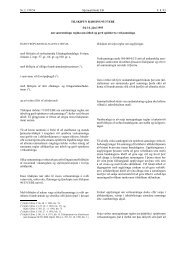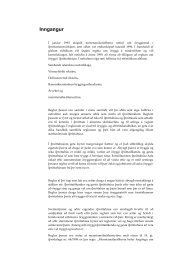Arts and Cultural Education in Iceland : Professor Anne Bamford
Arts and Cultural Education in Iceland : Professor Anne Bamford
Arts and Cultural Education in Iceland : Professor Anne Bamford
You also want an ePaper? Increase the reach of your titles
YUMPU automatically turns print PDFs into web optimized ePapers that Google loves.
We have seen a very positive effect on the culture of the school. We f<strong>in</strong>d that music is better organised when we are<br />
part of the school (not separate). The children have more time <strong>and</strong> it is more popular with parents.<br />
It has a very positive social effect. It is not just <strong>in</strong> music either but <strong>in</strong><br />
many th<strong>in</strong>gs. The children here are not shy. They are more confident <strong>and</strong> creative <strong>and</strong> I would say there has been a<br />
positive <strong>in</strong>fluence on the whole system. Pupils <strong>and</strong> teachers show more <strong>in</strong>itiative.<br />
We have also noticed that those children who take the additional private music lessons are the best pupils. They<br />
achieve the best <strong>and</strong> there is not any negative effect from them miss<strong>in</strong>g time <strong>in</strong> school to go to music lessons. I can<br />
see only positive benefits.<br />
We have a school of musicians, they concentrate more as audiences, they are happy to be creative <strong>and</strong> communicate.<br />
The atmosphere <strong>and</strong> culture of the school is good. I wish more pupils would cont<strong>in</strong>ue <strong>in</strong>to the private music lessons<br />
though. Only around half the pupils do.<br />
I would say culture is the sp<strong>in</strong>e of the school. Not only the music school, but also the after school youth centre. I<br />
would like to do more <strong>in</strong> the other art forms. Drama <strong>and</strong> dance is done a bit, but only <strong>in</strong> music lessons. Then it is<br />
ma<strong>in</strong>ly traditional dances. We do offer quite a few cultural electives for older pupils <strong>and</strong> these are always very<br />
popular.<br />
Years 7-10 do a musical theatre performance once a year. We get a professional Director to work with the pupils. We<br />
also try to organise visits about 3-4 times a year of orchestras or jazz ensembles. Children with special needs are<br />
<strong>in</strong>tegrated <strong>in</strong>to all lessons. Percussion works especially well with special needs pupils. I notice they have a high degree<br />
of concentration when they play. When we do more of the arts <strong>in</strong> school, it encourages more children to go to after<br />
school music (less than 10% of our pupils attend after school music but this is slowly improv<strong>in</strong>g).<br />
We saw music school numbers improve when the music school started to come <strong>and</strong> teach <strong>in</strong> the school. The viol<strong>in</strong><br />
teacher comes here once or twice a week. The children go to music lessons dur<strong>in</strong>g school time <strong>and</strong> this has really<br />
encouraged them. We have not seen any negative effects. Grades 1 <strong>and</strong> 2 all come together to play the flute. The<br />
music teacher has taught them the recorder.<br />
While general op<strong>in</strong>ion supports the view that music schools should be <strong>in</strong>tegrated <strong>in</strong>to the<br />
compulsory school, the official position of the Icel<strong>and</strong>ic Musician’s Union (FIH) is that the<br />
st<strong>and</strong>ard of music education is much better <strong>in</strong> the ‘special’ music school. They argue that <strong>in</strong><br />
general, the facilities <strong>and</strong> conditions <strong>in</strong> the compulsory school are <strong>in</strong>ferior to the conditions <strong>in</strong><br />
the music school. While they acknowledge there are good <strong>and</strong> bad sides to music be<strong>in</strong>g located<br />
on a separate site or as part of a school, the overall view is one that feels that the adm<strong>in</strong>istration<br />
<strong>and</strong> facilities are better <strong>in</strong> music schools <strong>and</strong> that, “The music school pr<strong>in</strong>ciples <strong>and</strong> environment<br />
must be ma<strong>in</strong>ta<strong>in</strong>ed”. They argue further, “There are too many conflicts when music is <strong>in</strong> the<br />
school. It will always be a problem. The atmosphere <strong>in</strong> schools is not right.” They concede<br />
though that a well-designed music ‘annex’ attached to schools may be a good compromise as it<br />
could capture the best elements of both systems. They give an example, “We have a project with<br />
a public school. In this school only one pupil was play<strong>in</strong>g, but now 200 pupils are play<strong>in</strong>g, but<br />
ironically this programme has just had the fund<strong>in</strong>g removed. The FIH also cautions, “The concern<br />
<strong>in</strong> our profession is that th<strong>in</strong>gs start to change <strong>and</strong> then there is a tendency for everyth<strong>in</strong>g to<br />
shift downhill. This is the experience when we look at what has happened <strong>in</strong> some of our<br />
neighbour<strong>in</strong>g countries. We have a fear of the system be<strong>in</strong>g watered down. The association<br />
further argues that if music teachers are placed <strong>in</strong> compulsory schools, they become “isolated<br />
<strong>and</strong> f<strong>in</strong>d it difficult.” They suggest that for music <strong>in</strong> schools to work, at least 2 teachers would<br />
need to be placed together <strong>in</strong> a school. They contend that any placements of music teachers <strong>in</strong><br />
compulsory school should not be <strong>in</strong>stead of music schools but rather as an addition to the<br />
current system.<br />
Other music schools are consider<strong>in</strong>g closer ties with the compulsory schools but feel that<br />
there are a number of obstacles to overcome for this to be really successful, as the follow<strong>in</strong>g<br />
comment exemplifies:<br />
42



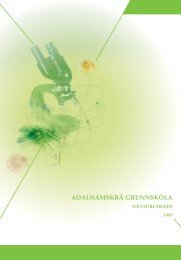
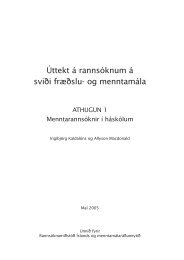

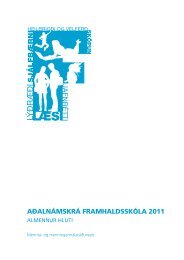
![Aðalnámskrá tónlistarskóla : rytmÃsk tónlist [Eingöngu á rafrænu formi]](https://img.yumpu.com/50843672/1/184x260/aaalnamskra-tanlistarskala-rytma-sk-tanlist-eingangu-a-rafranu-formi.jpg?quality=85)



